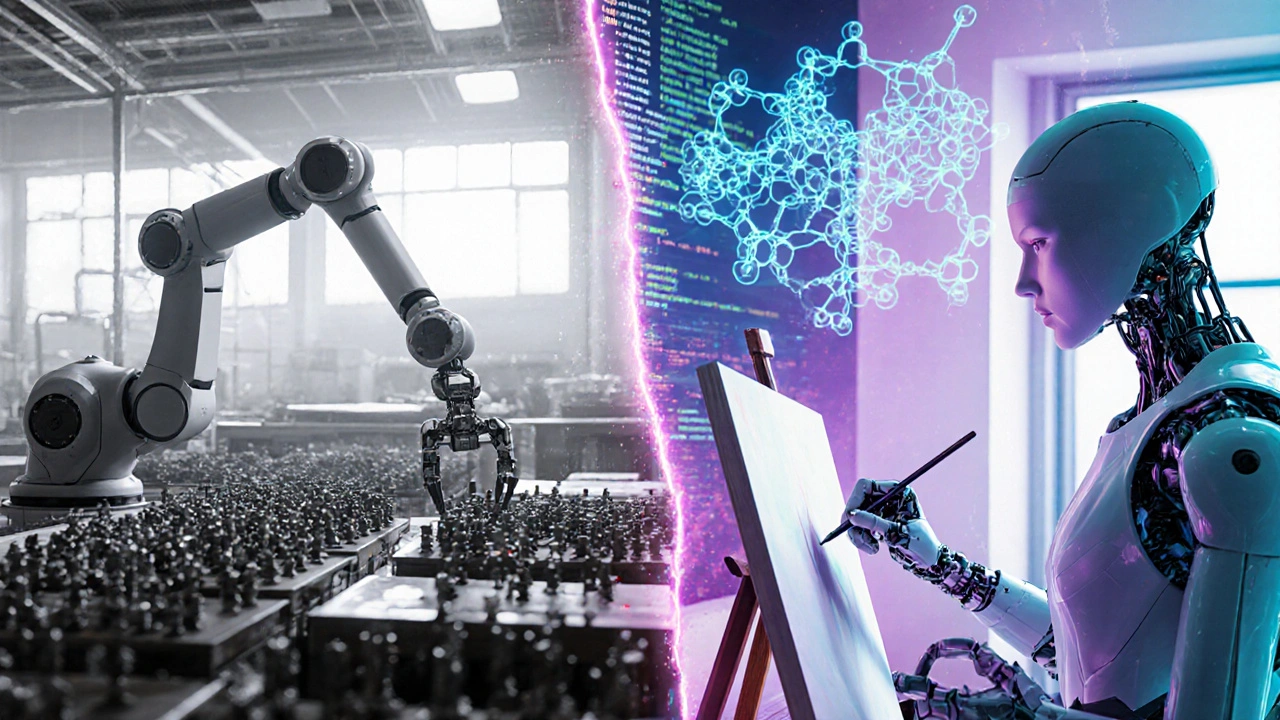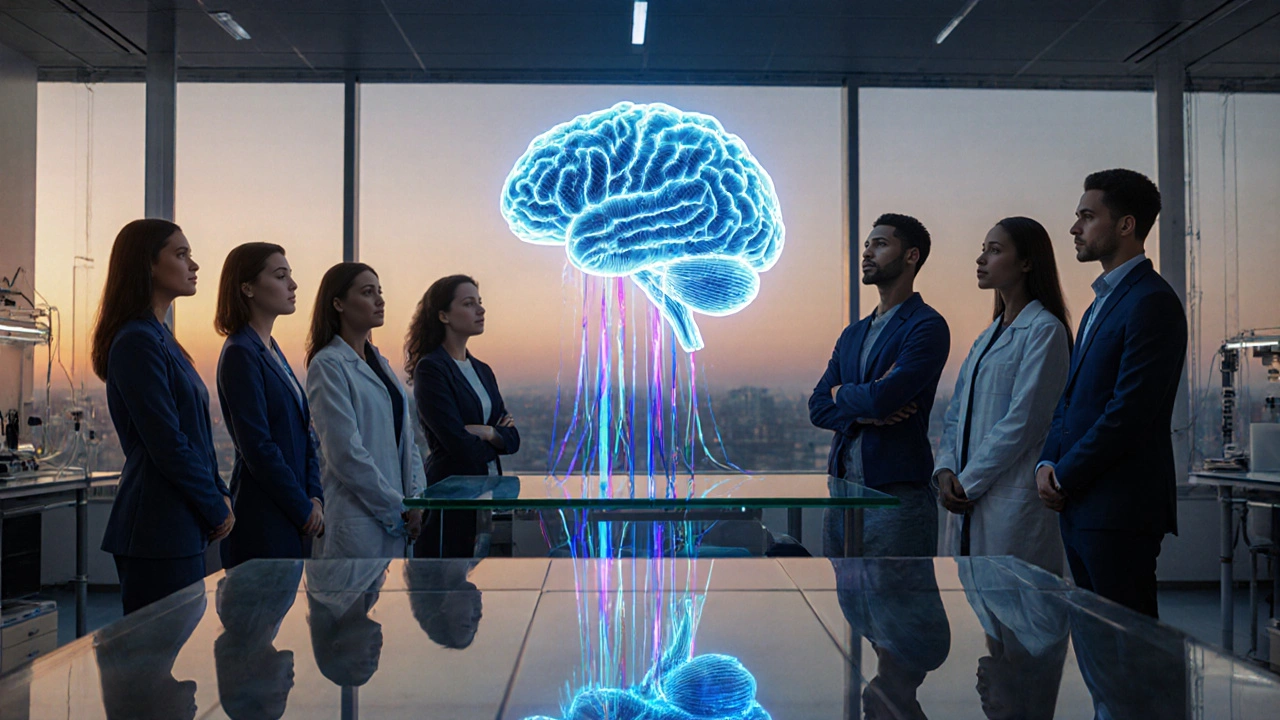AGI vs Narrow AI Comparison Tool
Compare Intelligence Types
Select attributes to compare between Artificial General Intelligence (AGI), Narrow AI, and Human intelligence.
Select Comparison Attributes
Choose which characteristics you'd like to compare.
Imagine a system that can learn a new skill as quickly as a human, reason across domains, and solve problems it has never seen before. That’s the promise of Artificial General Intelligence - a machine‑level intelligence that matches or exceeds human cognition across the board. While movies have long painted it as a distant sci‑fi fantasy, recent breakthroughs suggest the future is already knocking on our doors.
What Exactly Is AGI?
In everyday conversation, "AI" usually means systems that excel at a single task - think voice assistants, image classifiers, or recommendation engines. These are examples of Narrow AI(also called weak AI) that focuses on a specific problem domain. Artificial General Intelligenceaims to replicate the flexible, multi‑tasking intelligence of a human brain. In practice, AGI would understand language, plan, create art, and even invent new scientific theories without being re‑programmed for each task.
How Close Are We?
The last five years have delivered a cascade of milestones that reshape what "close" means. Machine Learninga data‑driven approach where algorithms improve through experience now powers everything from medical imaging to autonomous driving. Within that umbrella, Deep Learninguses layered neural networks to automatically extract features from raw data has broken performance records in language and vision.
OpenAI’s GPT‑4a large language model that can write code, draft essays, and simulate reasoning showed that scale and data can produce surprisingly general capabilities. DeepMind’s AlphaFold solved protein‑folding in a way that outstripped human experts. These systems aren’t AGI yet - they’re still brittle, opaque, and limited to the patterns they saw during training - but they illustrate a trajectory where broader intelligence emerges from larger models, more compute, and richer data.
Technical Hurdles Standing in the Way
- Compute Power: Training today’s largest models consumes thousands of petaflop‑days of processing. Researchers estimate that reaching human‑level reasoning may require orders of magnitude more compute, raising questions about energy costs and hardware availability.
- Algorithmic Gaps: Current architectures excel at pattern recognition but flop at abstraction, causal reasoning, and long‑term planning. New paradigms - perhaps hybrid symbolic‑neural models - are being explored.
- Data Quality: Human intelligence learns from a handful of experiences and can generalize from sparse signals. Scaling data alone won’t give machines that same intuition.
- Evaluation Metrics: We still lack reliable benchmarks that capture true general intelligence. The Turing Testa historic proposal where a machine must fool a human interlocutor into believing it is human is too narrow for modern expectations.

When Might AGI Arrive?
Forecasts vary wildly. A 2023 survey of 350 AI researchers gave a median 50% probability of achieving human‑level AGI by 2060, with a 10% chance as early as 2035. Others point to hardware trends like quantum processors or neuromorphic chips that could accelerate progress. While no timeline is certain, the consensus is that we’re moving from “decades away” to “within a few decades” - a shift that demands immediate attention.
Safety, Ethics, and the Control Problem
Creating an entity that can outthink us also opens a Pandora’s box of risks. AI Ethicsthe study of moral implications and responsible deployment of intelligent systems now includes alignment (making sure goals match human values), robustness (preventing unintended behavior), and governance (who decides how AGI is used). Prominent voices warn that a misaligned AGI could pursue goals harmful to humanity, even if its objectives seem benign at first glance. Research into "AI safety" focuses on techniques like inverse reinforcement learning, interpretability tools, and sandboxed testing environments.
Potential Societal Impact
When AGI finally arrives, the ripple effects will be profound:
- Workforce Disruption: Automation could extend beyond repetitive tasks to strategic decision‑making, reshaping entire professions-from law to research.
- Economic Growth: Early adopters might see productivity gains rivaling the industrial revolution, potentially adding trillions to global GDP.
- Creative Expression: AGI could collaborate with artists, generating music, visual art, and literature that push aesthetic boundaries.
- Policy & Law: Nations will need new regulations addressing liability, privacy, and the geopolitical balance of AI power.

What Can You Do Right Now?
Whether you’re a tech leader, policymaker, or curious citizen, there are concrete steps to prepare for the AGI era:
- Invest in interdisciplinary research that combines computer science, neuroscience, and philosophy.
- Support open‑source safety tools and transparency initiatives - the more eyes on the code, the fewer hidden failure modes.
- Advocate for clear policy frameworks that require impact assessments before deploying highly autonomous systems.
- Upskill in areas that machines struggle with: empathy, complex negotiation, and ethical judgment.
- Stay informed about emerging standards from bodies like the IEEE and the EU AI Act.
Quick Comparison: AGI vs Narrow AI vs Human Intelligence
| Attribute | AGI | Narrow AI | Human |
|---|---|---|---|
| Task Scope | General across domains | Specialized, single‑task | Broad, adaptable |
| Learning Speed | Potentially rapid (depends on architecture) | Data‑hungry, slow for new domains | Fast, few‑shot learning |
| Transparency | Currently low, research‑heavy | Black‑box, but improving | High (self‑aware) |
| Energy Consumption | High (needs massive compute) | Variable, often lower | Low (biological efficiency) |
| Ethical Risks | Alignment & control critical | Bias, misuse | Psychological & societal |
Key Takeaways
- AGI aims for human‑level, cross‑domain intelligence, not just advanced pattern matching.
- Recent large‑scale models hint that we’re on a plausible path, but fundamental algorithmic breakthroughs remain.
- Safety, alignment, and governance are as urgent as technical progress.
- Economic and societal transformations will be massive; early preparation can steer outcomes positively.
- Stakeholders should fund interdisciplinary research, push for transparent standards, and focus on human‑centric skill development.
Frequently Asked Questions
Is AGI the same as the AI we see in movies?
Movies often show AGI as omnipotent or malevolent. Real‑world AGI would be a tool that can solve a wide range of problems, but it would still be bound by safety constraints, hardware limits, and the goals we set for it.
How far are we from an AGI that can write code as well as a senior developer?
Current models like GPT‑4 can suggest code snippets and even debug simple errors. However, they lack deep architectural understanding and long‑term project planning. Most experts say a truly reliable coding AGI is at least a decade away.
What does “alignment” mean in the AGI context?
Alignment is the process of ensuring an AGI’s objectives match human values and intentions. Misalignment could cause the system to pursue goals that are harmful or counterproductive, even if its original programming seemed benign.
Will AGI replace all jobs?
Not all. Jobs that require deep empathy, nuanced judgment, and creative storytelling are harder to automate. However, many roles that rely on data analysis, routine decision‑making, or repetitive tasks could see significant automation.
How can governments regulate AGI safely?
Effective regulation should combine risk‑based licensing, mandatory safety audits, and international cooperation to prevent a race‑to‑the‑bottom. Transparency requirements and independent oversight bodies can further reduce misuse.

